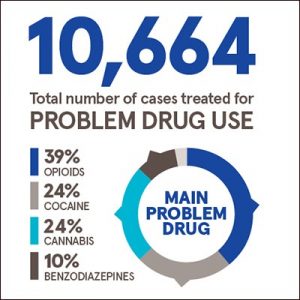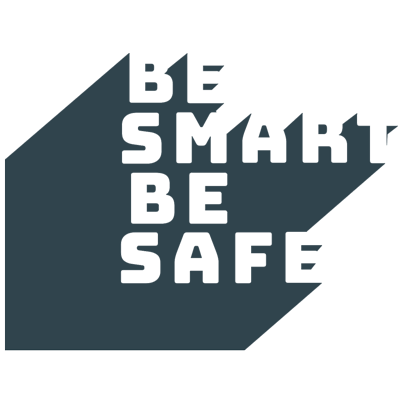The latest figures from the Health Research Board (HRB) show the number of cases presenting for cocaine treatment continued to rise between 2018 and 2019. The number of cases entering treatment for cocaine as a main problem drug has trebled between 2013 and 2019.
Opioids remain the most common drug among cases treated for problem drug use for the first time. However, cocaine has overtaken cannabis as the second most common drug that people enter treatment for.
Cocaine Trends
- A total of 2,560 cases were treated for problem cocaine use in 2019, more than three times the number of cases reported in 2013 (708 cases).
- The number of cases treated for crack cocaine is also increasing, with 367 cases reporting crack cocaine as a main problem drug in 2019, an increase from 255 cases reported in 2018.
- Men accounted for approximately eight-in-ten cocaine cases each year since 2013.
- Three-in-ten cocaine cases reported being in paid employment in 2019, an increase from two-in-ten cases in 2013.
- Mixing drugs (problem use of more than one drug) among cocaine cases has decreased from four-in-five cases in 2013 to three-in-five cases in 2019.
- The drugs most commonly taken with cocaine are alcohol, followed by cannabis and benzodiazepines.
Dr Mairead O’ Driscoll, Interim Chief Executive at the Health Research Board says,
‘The figures published today illustrate the level of cocaine use in Irish society. The consistent rise in demand for cocaine treatment, coupled with an increase in cases in paid employment and a decrease in proportion of cases mixing drugs reflects clear changes in patterns of drug use.
‘The HRB has a key role monitoring drug-related trends to ensure decision makers are equipped to assess drug-related harms, increase awareness of drug-use risks and develop evidence-based initiatives to reduce harm and support recovery.’
Commenting on these latest figures from the National Drug Treatment Reporting System, Dr Anne Marie Carew, research officer at the HRB says,
‘In general, those seeking treatment for cocaine are male, 30 years of age, in paid employment and most likely to use alcohol as an additional drug. However, a rise in reporting of crack cocaine is a worrying trend where cases with chronic problem drug use, mix crack cocaine with opioids. These cases are more likely to be unemployed and homeless. It is important that this distinction is noted in order to monitor trends and tailor treatments accordingly.’
‘Polydrug use, or using more than one drug, remains a problem for more than half of cases presenting for treatment. It should be noted that there has been an overall decline in the proportion of treated cases who are taking more than one drug since 2013. A downward trend in the proportion of polydrug cases is positive, because mixing drugs increases the risk of overdose and can impact recovery,’ concludes Dr Carew.
Key findings on drug treatment in 2019
In 2019, a total of 10,664 cases were treated for problem drug use, an increase from 10,274 in 2018.
Main problem drug (excluding alcohol)
- Opioids (mainly heroin) were the most common main problem drug reported, accounting for 39% of cases treated in 2019, a decrease from 51% of cases in 2013.
- Cocaine was the second most common main drug reported, accounting for 24% of cases treated in 2019, an increase from 8% of cases in 2013.
- Cannabis was the third most common main drug, accounting 23.5% of cases treated in 2019, a decrease from 29% of cases in 2013.
- Benzodiazepines were the fourth most common main problem, accounting for approximately 10% of cases each year from 2013 to 2019.
- Pregabalin (Lyrica) as a main problem drug was reported by a small number of cases in 2019 (39 cases), however, the number has almost doubled compared to 2018 (21 cases).
Polydrug use (problem use of more than one drug)
- The proportion of cases using more than one drug decreased from 63% of cases in 2013 to 55% of cases in 2019.
- Alcohol was the most common additional drug reported in 2019 followed by cannabis, benzodiazepines and cocaine.
- MDMA (ecstasy) as a main problem accounted for a small number of cases (47 cases); however, significantly more cases reported MDMA as an additional problem drug (493 cases).
Socio-demographic characteristics (all drugs)
- The median age of cases increased from 29 years in 2013 to 31 years in 2019.
- Men accounted for approximately seven-in-ten drug treatment cases each year since 2013.
- Young people under 18 years of age accounted for 822 of cases in 2019, an increase from 732 cases in 2018.
- The majority of cases were unemployed. However, there has been a decrease in unemployment with a corresponding increase in the number of cases in paid employment over the seven-year period.
- The number of cases recorded as homeless has increased, from 581 cases in 2013 to 1,173 cases in 2019.
- The number who reported Irish Traveller as their ethnicity increased from 231 cases in 2013, to 320 cases in 2019.
* It is important to note that each record in the NDTRS database relates to a treatment episode (a case), and not to a person. This means that the same person could be counted more than once in the same calendar year if they had more than one treatment episode in that year.
The full report is available on the HRB website. An infographic that outlines key data is also available for download.
For further information, infographics or to organise interviews with experts, please contact:
Gillian Markey – Communications Manager, Health Research Board
m 087 2288514, t +353 1 2345103, e gmarkey@hrb.ie
The Health Research Board (HRB) is the lead agency supporting and funding health research in Ireland. We manage four health information systems in the areas of alcohol and drug use, drug deaths, disability and mental health and generate evidence to inform health policy. Our aim is to improve people’s health, build health research capacity and underpin developments in health service delivery.


